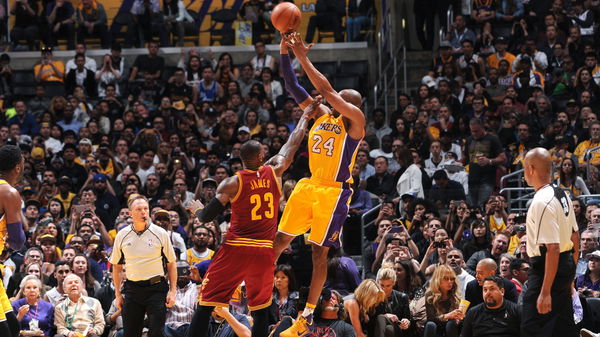
Imago
Image Credits: IMAGN

Imago
Image Credits: IMAGN
When an NBA Finals opener draws the weakest ratings in nearly four decades, excluding the unusual pandemic years, you know something’s missing. And it’s not just fans or casual viewers feeling the void. Even a former Indiana Pacers star, whose old team is playing in the Finals, couldn’t hide his dissatisfaction. That tells you the concern runs deeper than just numbers. So, what exactly is going wrong? And why does the absence of the likes of LeBron James and Kobe Bryant seem to make all the difference? The said ex-Pacer might have the answer you’re looking for.
Watch What’s Trending Now!
That voice of concern came from Jeff Teague, who opened up during a recent episode of his Club 520 Podcast. The conversation took a turn when co-host DJ Wells shared his frustration with the lack of media buzz around the Finals. And let’s be real—it’s not every year that the championship series gets this kind of cold shoulder. According to official numbers, Game 1 between the Oklahoma City Thunder and the Indiana Pacers managed to pull in only 8.91 million viewers with a 4.7 rating on ABC. That’s the lowest for a Finals Game 1 since 1988, barring the COVID-interrupted 2020 and 2021 seasons. Such a plight of this mega-event has left Jeff Teague doing a double-take on what the issue is.
Teague didn’t mince words when pointing to the obvious challenge—both teams in this NBA Finals series come from smaller markets that don’t draw much attention from the average sports fan. “These two teams mirror each other, It’s a great basket. If you’re a basketball fan, it’s a great series to watch. But if you just an average sports fan, it’s awful… Cause the market’s just… You’re not really familiar with anything in Indiana… You’re not familiar with nothing with OKC,” he said on the Club 520 Podcast, adding that superstars like LeBron James and Kobe Bryant never faced such an issue. The reason is the global popularity of these icons, which was never limited to their NBA stints.
ADVERTISEMENT

Getty
LOS ANGELES, CA – MARCH 10: Kobe Bryant #24 of the Los Angeles Lakers shoots the ball during the game against LeBron James #23 of the Cleveland Cavaliers on March 10, 2016, at STAPLES Center in Los Angeles, California. NOTE TO USER: User expressly acknowledges and agrees that, by downloading and/or using this Photograph, user is consenting to the terms and conditions of the Getty Images License Agreement. Mandatory Copyright Notice: Copyright 2016 NBAE (Photo by Noah Graham/NBAE via Getty Images)
“NBA’s changed so much. Cause you don’t have stars of stars. Like I said, when you had Kobe, he was like a star of stars. Like, if you didn’t watch basketball, you still knew who Kobe Bryant was… If LeBron was in this Finals, this would be a whole different story. Because if you don’t watch basketball, you still know LeBron James is,” Teague explained. It’s a reminder that sometimes, it’s not just about the game—it’s about the people who elevate it. And right now, fans seem to be missing that kind of magic. And all that because of one change that benefited teams like the Pacers and OKC.
ADVERTISEMENT
The change that made teams with smaller markets better, but hurt the NBA’s business
Let’s face it—when the NBA Finals feature two small-market teams, the league’s viewership usually takes a hit. Just think back to 2005. That year, the San Antonio Spurs and Detroit Pistons squared off in Game 1, and only 10.6 million tuned in. Fast forward to 2007 when the Spurs met LeBron’s Cleveland Cavaliers, and the opener barely attracted 9.3 million viewers. That kind of drop-off says a lot about what the casual fan wants to watch.
Now, here’s the thing: the NBA has typically been able to sidestep that issue. Major market franchises like the Lakers, Celtics, Bulls, and, more recently, the Warriors have found their way into the Finals again and again. Their presence keeps the spotlight firmly fixed on the league when it matters most. And don’t think for a second that the NBA isn’t banking on that trend sticking around. The NBA would love to see Luka Doncic establish the Lakers as the NBA’s next dynasty. Love it or hate it, star power in Hollywood just hits different. But here’s where the shift really began.
When the NBA introduced the supermax in 2017, it made a clear play to keep stars loyal to the teams that drafted them. Since then, it’s been much harder for big-market teams to lure talent away. Without that rule, Giannis Antetokounmpo and Nikola Jokic might have been suiting up in Miami or L.A. years ago. Yes, the Super Team era skewed competitive balance—but from a business perspective, it worked. Big stars in big cities? The league could sell that all day. Today’s reality? Success comes mostly from within.
Teams like the Thunder and Pacers didn’t chase flashy free agents—they built smart and patient. Meanwhile, squads like the Suns, who loaded up in the offseason, are now staring down uncertain futures. So, as the game evolves, maybe it’s time the league’s hype machine evolved with it.
ADVERTISEMENT
ADVERTISEMENT
ADVERTISEMENT
ADVERTISEMENT

